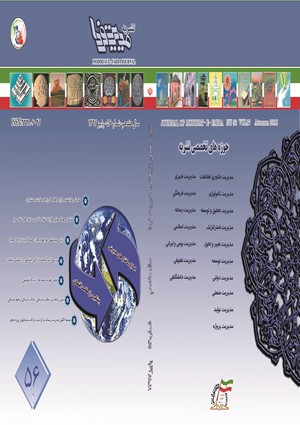Creating a systemic model for identifying the success factors of establishing a knowledge management system in aeronautical organizations and providing improvement solutions (case study: one of the Air Organizations)
Subject Areas :
1 -
Keywords: Knowledge management system, Systemic approach, Fuzzy DEMATEL.,
Abstract :
In today's world, many organizations with low profits, limited capital and intensive competition, and at the same time must meet the endorsements of shareholders, are successful organizations that can create better opportunities and create new opportunities. Given the importance of knowledge and its pivotal role in the knowledge age, organizations, especially knowledge-based organizations, whose knowledge is a strategic source and a key factor in acquiring and maintaining the core competence of the organization, is essential for establishing knowledge management and identifying obstacles. Thought ahead with implementation with a systematic approach to develop the capabilities that lead to the development of knowledge as a key source of enterprise. In order to achieve this goal, a knowledge-based knowledge-based airspace-based knowledge management organization was considered and a system model was mapped out. At first, various factors that can be effective were identified through questionnaires and interviews and literature reviews. Then, the causal and impulsive diagrams, which are one of the tools used in the dynamics dynamics methodology, were drawn and finally, these factors were prioritized using the fuzzy dematerial method and the effective and effective factors were identified. The rate of knowledge sharing, the number of human resources with a high level of knowledge and experience, the quality of individual work of the staff, the culture of sharing knowledge and the level of attention of senior executives to the IT infrastructure were the five most important and important factors. These factors were used as the basis for developing knowledge management strategies in the organization in order to achieve effective strategic strategies. In today's world, many organizations with low profits, limited capital and intensive competition, and at the same time must meet the endorsements of shareholders, are successful organizations that can create better opportunities and create new opportunities. Given the importance of knowledge and its pivotal role in the knowledge age, organizations, especially knowledge-based organizations, whose knowledge is a strategic source and a key factor in acquiring and maintaining the core competence of the organization, is essential for establishing knowledge management and identifying obstacles. Thought ahead with implementation with a systematic approach to develop the capabilities that lead to the development of knowledge as a key source of enterprise. In order to achieve this goal, a knowledge-based knowledge-based airspace-based knowledge management organization was considered and a system model was mapped out. At first, various factors that can be effective were identified through questionnaires and interviews and literature reviews. Then, the causal and impulsive diagrams, which are one of the tools used in the dynamics dynamics methodology, were drawn and finally, these factors were prioritized using the fuzzy dematerial method and the effective and effective factors were identified. The rate of knowledge sharing, the number of human resources with a high level of knowledge and experience, the quality of individual work of the staff, the culture of sharing knowledge and the level of attention of senior executives to the IT infrastructure were the five most important and important factors. These factors were used as the basis for developing knowledge management strategies in the organization in order to achieve effective strategic strategies.
[1]شکوهی بیدهندی،محمد سجاد،(1393)، نظام جامع مدیریت دانش دفاعی،کارشناسی ارشد،مهندسی صنایع
[2]جعفری, مصطفی،(1382)، مدیریت دانش در سازمان.تدبیر.14(142)
[3]داونپورت،تامس اچ،لارنس پروساک(1379) ،مدیریت دانش.ترجمه حسین رحمان سرشت،تهران:نشر ساپکو
[4]الوانی،مهدی(1382)، الگویی برای سنجش عملکرد در بخش دولتی،فصلنامه مطالعات مدیریت بهبود و تحول،دوره 10،شماره 37
[5]Chang, H.-H. and W.-C. Huang, Application of a quantification SWOT analytical method. Mathematical and computer modelling, 2006. 43(1): p. 158-169.
[6] Sweeney, L.B. and J.D. Sterman, Bathtub dynamics: initial results of a systems thinking inventory. System Dynamics Review, 2000. 16(4): p. 249-286.
[7] Helms, J.E., Black and White racial identity: Theory, research, and practice. 1990: Greenwood Press.
[8] Zack, M.H., Developing a knowledge strategy. California management review, 1999. 41(3): p. 125-145
[9] Umble, E.J., R.R. Haft, and M.M. Umble, Enterprise resource planning: Implementation procedures and critical success factors. European journal of operational research, 2003. 146(2): p. 241-257.
[10] Wang, M.-H. and T.-Y. Yang, Investigating the success of knowledge management: An empirical study of small-and medium-sized enterprises. Asia Pacific Management Review, 2016. 21(2): p. 79-91
[11] Kuo, R.-Z. and G.-G. Lee, Knowledge management system adoption: exploring the effects of empowering leadership, task-technology fit and compatibility. Behaviour & Information Technology, 2011. 30(1): p. 113-129.
[12] Grill-Spector, K., Z. Kourtzi, and N. Kanwisher, The lateral occipital complex and its role in object recognition. Vision research, 2001. 41(10): p. 1409-1422.
[13] Alessi, S. and N. Petry, Pathological gambling severity is associated with impulsivity in a delay discounting procedure. Behavioural Processes, 2003. 64(3): p. 345-354.
[14] Coyle, G., The practice of system dynamics: milestones, lessons and ideas from 30 years experience. System Dynamics Review, 1998. 14(4): p. 343-365.
[15] Wu, W.-W., Segmenting critical factors for successful knowledge management implementation using the fuzzy DEMATEL method. Applied Soft Computing, 2012. 12(1): p. 527-535.
[16] Teece, D.J., Strategies for managing knowledge assets: the role of firm structure and industrial context. Long range planning, 2000. 33(1): p. 35-54.
[17] Shi, T. and R. Gill, Developing effective policies for the sustainable development of ecological agriculture in China: the case study of Jinshan County with a systems dynamics model. Ecological Economics, 2005. 53(2): p. 223-246.
[18] Nevo, D. and Y.E. Chan, A Delphi study of knowledge management systems: Scope and requirements. Information & Management, 2007. 44(6): p. 583-597.
[19] Yew Wong, K., Critical success factors for implementing knowledge management in small and medium enterprises. Industrial Management & Data Systems, 2005. 105(3): p. 261
[20] Saysel, A.K., Y. Barlas, and O. Yenigün, Environmental sustainability in an agricultural development project: a system dynamics approach. Journal of environmental management, 2002. 64(3): p. 247-260.


